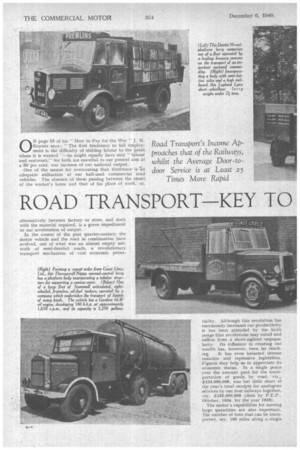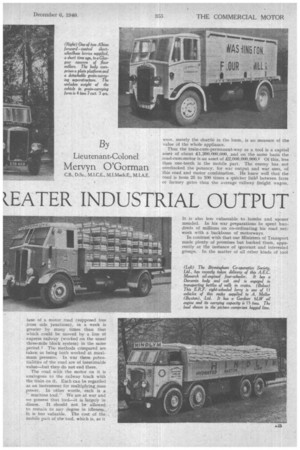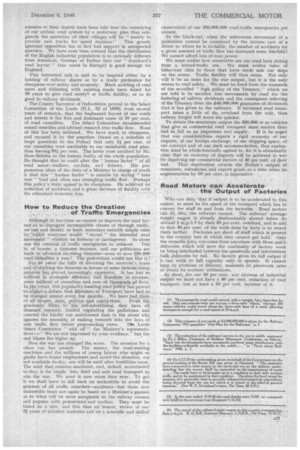ROAD TRANSPORT KEY TO &EATER INDUSTRIAL OUTPUT
Page 26

Page 27

Page 28

Page 29

If you've noticed an error in this article please click here to report it so we can fix it.
By
Lieutenant-Colonel
Mervyn O'Gorman
C.B., D.Sc., M.I.C.E., M.I.Mech.E., M.I.A.E. ON page 18 of his " How to Pay for the War" J. M. Keynes says: " The first hindrance to full employment is the difficulty of shifting labour to the point where it is wanted "—he might equally have said " labour and materials," for both are essential to our present aim at a 50 per cent, war increase of our national output.
One of the means for overcoming that hindrance is In adequate utilization of our half-used commercial road vehicles. The absence of these passing between the street of the worker's home and that of his place of work, or, alternatively between factory or store, and dock with the material required, is a grave impediment to our acceleration of output.
' In the course of the past quarter-century the motor vehicle and the road in combination have evolved, out of what was an almost empty network of semi-derelict roads, a revolutionary transport mechanism of vast economic poten tiality. Although this revolution has enormously increased our productivity it has, been attended by the birth pangs that revolutions may entail and suffers from a short-sighted unpopularity. Its influence in creating our wealth has, however, been far reach ing. It has even breasted intense taxation and repressive legislation. Figures may help us to appreciate its economic status. In a single peace year the amount paid for the transportation of goods by road, viz., £133,000,000, was but little short of the year's total receipts for analogous services by our four railways together, viz., £155,000,000 (data by PEP., October, 1934, for the year 1933).
The motor's capabilities for moving large quantities are also important. The number of tons that can be transported, say, 100 miles along a single
lane of a motor road (supposed free from side junctions), in a week is greater by many times than that which could be moved by a line Of express railway (worked on the usual three-mile block system) in the same period.' The methods compared are taken as being both worked at maximum pressure. In war these potentialities of the road are of inestimable value—but they do not end there.
The road with the motor on it is analogous to the railway track with the train on it. Each can be regarded as an instrument for multiplying man power. In other words, each is a " machine tool," We are at war and we possess that tool—it is largely in disuse. It should not be allowed to remain to any degree in idleness. It is too valuable. The cost of the mobile part of the tool, which is, as it were, merely the shuttle in the loom, is no measure of the value of the whole appliance.
Thus the train-cum-permanent-way as a tool is a capital asset of about £1,200,000,000, and on the same basis the road-cum-motor is an asset of £2,000,000,000.2 Of this, less than one-tenth is the mobile part. The enemy has not overlooked the potency, for war output and war uses, of this wad and motor combination. He knew well that the road is from 25 to 100 times a quicker link3 between farm or factory gates than the average railway freight wagon.
It is also less vulnerable to bombs and sooner mended. In his war preparations he spent hundreds of millions on co-ordinating his road net. work with a backbone of motorways.
In contrast with that our Ministers of Transport made plenty of promises but bucked them, apparently at the instance of ignorant and interested groups. In the matter of all other kinds of tool we are more awake. Thus the Minister of Supply, on August 15, 1940, wrote 20,000 letters to every owner of a lathe, grinder, Shaper or drill that was not in full use offering to purchase them so that they might be put at the country's service.
Yet the Nation is gravely neglecting to get her £2,000,000,000 machine tool of road transport into a fraction of its ful: use for production. Its service is so farreaching that on it depends the possibility of uninterrupted work in most factories and, Lherefors, the speeding up of their output, the salving of waste, the collection of farm produce and the transport of employees to their jobs all over the land. Its quick service minimizes the lock-up of capital in every industrial and factory store and facilitates the use by any one factory of such expensive machine tools
as may be temporarily out of use in any other. It can fill up at short notice those gaps and deficiencies of factory stocks that frequently result from the overloaded condition of our railways, from congestion at our docks, from the cutting of railway lines by bombs, or from the irregularities of convoys, etc. These are the gaps that are prone to stop a factory's wheels, reduce output, increase costs and impede re-employment in spite of the demands of war, which, if anything can, may be described as unlimited.
In peace-time the motor and the road were proved by the free choice of business men and the test of hard cash to constitute in any pne year almost as great a fertilizer of national productivity as all the trains and permanent way of our four railways together. Indeed, the immense revival of the " light industries " since the motor era is largely ascribable to two factors: the promptness of road transport and its economic method of charging on the cost per ton mile. Transport by road has always had to struggle under a handicap caused by the contrasted forms of ownership in the road and rail systems respectively.
Unlike the railway companies, which have a unified control, for the purposes of their business, of . both the layout of their permanent way and of their trains, the ownership of the road-transport mechanism is not unified but sub-divided. Each of the two sorts of control is scattered over the country so that neither is motivated by the general organization of road transport. On the one band private firms direct the mobile " shuttle " (the motor vehicle), on the other the fixed part of this loom (the permanent way, the layout of the road without which the vehicle is inert iron) is mainly in the independent control of a vague and uninformed local opinion expressed by 1,400 elected councils to most of which "through road transport (which gives one of the main economies of time and money afforded by the motor) appears as a source of local expenditure, of accidents and of noise, rather than as a mechanism for the production of wealth.
The " voter in the street " lumps motorists together as pleasure seekers and has a not-unnatural antipathy against any novelty that is attended by local inconveniences, costs and detriments. Its merits as a commercial machine may be great, but they are remote. They belong to the " long rim." Its demerits make livelier copy for the lay Press. They seem more actual. Our 1,400 highway authorities are liable to be subjected to interrogation by their electors about local economies, not about national production or output.
These electors have at no time received from the Minister of Transport any inducement to weigh up their own profitable share in the advancenjent of the Nation's wealth, in the increased national economies or in the increased
national output when fertilized by fluid, prompt and safe road transport. He had never told them that the accidents, noises and inconveniences could be cured by the proper road layout which he has neglected to make. He has not told. them that the motor mechanism has made available for meeting the bulk of road expenditure, the motor's payments to the „State of £100,000,000 a year,4 nor that that sum is twice as much as the annual total spent on roads in peacetime and four times as much as the £25,000,000 allocated from the motor taxes to the relief of highway rates.
Understandably, a majority of voters is opposed to extra highway rates and is well aware that a big expense wrongly falls on them for every improvement of the national road system. That expense should not fall on them, save in s6 far as they absorb road value. If the eventual national advantage of speedy and safe road transport enters their thoughts, it appears to them as if some persons unknown reap the benefit whilst they themselves pay (either in rates or taxes) money for roads for a general national advantage when the Treasury is pouching the road moneys.
Some w he have sought a salve to their economic con
sciences or their doubts have been told that the remedying of our archaic road system by a motor-way plan that safeguards the amenities of their villages will be " merely to
provide race tracks for speed maniacs." This grossly ignorant opposition has in fact had support in unexpected quarters. We have even been assured that the distribution of the English industrial population is so curiously different from American, German or Italian that our " drunkard's road layout " (the worst in Europe) is good enough for England.
This interested talk is said to be inspired either by a holding of railway shares or by a crude preference for cheapness over safety and economy. Much scolding of road users and tinkering with existing roads have failed for 30 years to give .road safety5 or traffic fluidity, or to do good to railway dividends. •
The County Surveyor of Oxfordshire proved to the Select Committee of the Lords (HL. 52 of 1939) from several years of research, that the haphazard layout of our roads and streets is the first and dominant cause of 70 per cent. of road casualties. The Select Committee recommended sound remedies and advised research into traffic flow. None of this has been initiated. We have stuck to cheapness, and excused it by the assertion (based on a schedule of inept questions to the Police) that only 1i per cent, of our casualties were ascribable to our unsuitable road plan, thus leaving 9S1 per cent. The latter were ascribed by Mr. Hore-Belisha to the human frailty of the whole population. He thought that he could alter the "human factor" of all -road users—walkers, cyclists, and drivers. His preposterous ideas of the duty of a Minister in charge of roads is that this " human factor " is curable by saying " take care " loud and often and strangling traffic flow. Perhaps this policy's mainappeal is its cheapness. He achieved no reduction of accidents and a great decrease of fluidity with the attendant economic loss.
How to Reduce the Creation of. Traffic Emergencies Although in War-time we cannot so improve the road layoutas to segregate incompatible classes of through traffic, we Call and should, at least, introduce suitable simple riles by ,which everyone would " reveal " his intended next movement" whethei On 'footway or carriageway. So alone can the creation of traffic -emergencies be reduced. This is, of' course, a tiresome measure, and our politicians are loath to -advocate anything tiresome—even to save 250,000 road-CiAnalties a year ! The pedestrian's would• not like it For 40 years the folly of diverting the motorist's taxes and of -shirking the tiresome intavour of some fatuous cheap panacea, has proved. increasingly expensive It has lost us millions in economic efficiency and therefore in revenue, some millions of casualties andtens of thousands oflives.' In the eyent, this popularity -hunting road policy has proved 'so abject a failure that .114.inisters. of Transport. have had to be changed almost every few months. We have had them
of all shapes, sizes,„ politics and convictions. From the graciously 41fent to the self-advertising, they have all shunned research, bunked regulating the pedestrian and courted the kindly but uninformed man in the street who ignores' the necessity of making research into the laws of safe traffic flow before propounding cures.The Lords Select Committee " told off" the Ministry's representatives :—" We are not impressed by your evidence," but the real blame lies higher up.
Now the war has changed the scene. The occasion for a clean cut has passed.. The money, the road-making machines and the millions of young labour who might sq. gladly have found employment and saved the situation, are not available to-day, nor will be until after hostilities cease. The need that remains unaltered, and, indeed,. accentuated to-day,. is for ample, free, fluid and safe road transport to win the war. We need it now more than ever. To get, 'it we 'shall have to fall back on makeshifts to avoid the greatest of all traffic retarders—accidents—but those new makeshifts must not again be based on a Minister's•guesses as to what will be most acceptable -en the railway owners and popular with pedestrians' and 'cyclists. They must be based on a new, and this time an honest, review of our 3-3, years of aceident Statistitaand Ph a Scientific and skilled' observation ofour 360,000,000 road-traffic emergencies per annum.
In the black-out, when the unforeseen movement of a pedestrian cannot be countered by the intense care of a driver to whom he is invisible, the number of accidents for a given amount ol traffic flow has increased some fourfold! We cannot afford loss of -man power.
We must realize how unsuitable are our road laws dating from a horsed-traffic era. We must evolve rules of behaviour akin to those that have made safe our ships on the ocean. Traffic fluidity will then ensue. Not only will it be an -asset for the war output, but it is the only means to road safety. We must be freed from the trammels of the so-called " high policy of the Treasury," which we are told is to sacrifice free movements by road for the fostering of railway dividends and the consequent relieving of the Treasury from the 240,000,000 guarantee of dividends that it has given to the railways. If increased road transport takes a little of tinoverload from the rails, then railway freight will move the quicker. •
To obtain the maximum output the 500,000 or so vehicles that give us commercial road transport must receive their fuel in full as an important war supply. lilt be urged that war considerations require a rigid •economy of our imports, of our foreign exchange, of our shipping space, of our convoys and of our dock accommodation, that contention must be whole-heartedly agreed to, for it is abundantly clear that no economy of imports will be achieved in war by depriving our commercial motors of 40 per cent, of their
fuel. That deprivation retards the Nation's output of munitions, neCesSaries and export goods at a time when its augmentation by 50 per cent, is imperative. .
Road Motors can Accelerate the Output of Factories Who can deny that if output is to be accelerated to this extent, so must be the speed of the transport which has to Convey the stuff to and from the factories. Road motors can do this, the railways cannot. The railways' average freight' wagon is already demonstrably slowed below its nOrmal m.4i.h.6 by their 50 per cent, overload, and to add to that 40..per cent, of the work done by lorry is to retard them further. Factories are short of stuff which is present in the country but of which they cannot get hold. Only the versatile lorry can come from anywhere with those quick deliveries which will save the continuity of factory work by being interlarded between the spasmodic and intermittent bulk deliveries by rail. No factory gives its full output if it can work to full capacity only in spasms. It cannot keep its promises of delivery, maintain its piecework rates or retain its workers' enthusiasm.
In short, „for our 50 per -cent, war increase of industrial output we must not have a 40 per cent. reduction of road transport, but at least a 50.per-cent increase of it.




















































